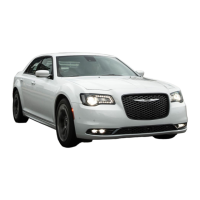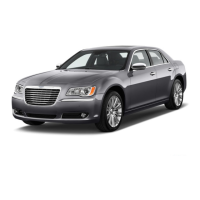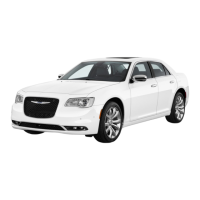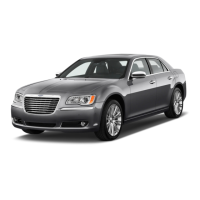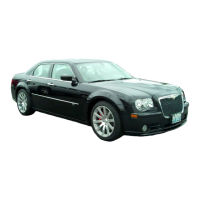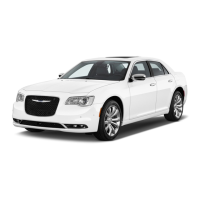Do you have a question about the Chrysler 300 2018 and is the answer not in the manual?
Explains how to navigate and use the owner's manual effectively.
Explains various symbols used throughout the owner's manual and on the vehicle.
Important safety warnings and cautions for operating the vehicle.
Information regarding modifications and alterations to the vehicle.
Details about the key fob, including its functions and emergency key.
Explains the keyless push button ignition system and its operating positions.
Instructions on how to use the remote start feature and its related messages.
Information about the Sentry Key Immobilizer System and key programming.
Explains how to arm and disarm the vehicle security alarm system.
Covers manual and power door locks, and passive entry features.
Details on power seats, driver memory seats, heated seats, and folding rear seats.
Information on head restraint adjustment and reactive head restraints.
Explains manual and power tilt/telescoping steering column adjustments.
Covers automatic dimming mirrors and outside mirror features.
Information on headlight switch, multifunction lever, and adaptive headlights.
Details on wiper operation, rain sensing wipers, and windshield washers.
Overview of automatic climate control and its functions.
Information on power window controls, auto-down/up features, and window lockout.
Instructions for operating the sunroof and power shade.
Steps to open and close the vehicle's hood.
Details on opening, closing, and safety features of the trunk.
Explains the automatic load leveling system.
How to program and use the HomeLink system.
Descriptions of the tachometer, speedometer, fuel, and temperature gauges.
Details on the display's location, controls, and selectable menu items.
Explains various warning lights and messages displayed in the instrument cluster.
Information on the OBD II system and its function.
Explains emissions inspection requirements and the OBD II system's readiness.
Covers Anti-Lock Brake System (ABS) and Electronic Brake Control (EBC).
Details on Blind Spot Monitoring, Forward Collision Warning, and TPMS.
Explains seat belts, SRS airbags, and child restraints.
Provides tips on transporting passengers, pets, and exhaust gas safety.
Steps for normal starting, cold weather operation, and handling engine failure.
Information on using an engine block heater for cold weather starting.
Guidelines for breaking in the new vehicle's drivetrain.
Instructions on how to apply and release the parking brake.
Covers transmission operation, interlocks, and gear selection.
Describes the Sport Mode feature for enhanced driving.
Explains the fuel economy feature that shuts off cylinders.
Information on the electric power steering system.
How to activate, set, and use the cruise control system.
Details on operating Adaptive Cruise Control, including settings and warnings.
Explains the parking assist system, sensors, and warning displays.
Information on LaneSense operation, warnings, and status indicators.
How to use the rearview camera and its guidelines.
Instructions for refueling the vehicle, including emergency fuel filler door release.
Information on load capacity, weight ratings, and overloading precautions.
Safety tips and information on towing limits and trailer requirements.
Guidelines for recreational towing of the vehicle.
Advice on driving in various conditions, including slippery surfaces and water.
How to operate hazard warning flashers for emergencies.
Information on the rearview mirror's ASSIST and SOS buttons for assistance.
Guide to replacing interior and exterior bulbs with bulb numbers.
Explains fuse replacement and provides a list of underhood and interior fuses.
Instructions and warnings for safely changing a tire.
Procedures and precautions for jump starting a vehicle with a discharged battery.
Steps to take if the engine overheats, including cooling system checks.
How to manually release the parking brake in emergencies.
Techniques for moving a vehicle stuck in mud, sand, or snow.
Procedures for towing a disabled vehicle using a commercial service.
Explains the EARS function for post-accident response.
Information about the EDR's purpose and data recording.
Details the automatic oil change indicator system and severe duty maintenance.
Identifies key components in the engine compartment for both 3.6L and 5.7L engines.
Recommends dealer service for expert maintenance and repairs.
Covers engine oil selection, viscosity, and disposal of used oil.
Information on selecting and replacing the engine oil filter.
Guidance on selecting and maintaining the engine air cleaner filter.
Recommendations for maintaining the air conditioning system.
How to inspect accessory drive belts for wear and damage.
Recommendations for lubricating body pivot points and lock cylinders.
Instructions for cleaning and replacing wiper blades.
Importance of exhaust system maintenance for preventing carbon monoxide entry.
Information on coolant checks, draining, flushing, and refilling the cooling system.
Details on brake system components, fluid level checks, and recommended fluids.
Covers lubricant selection and fluid changes for automatic transmissions.
Inspection of AWD system components for fluid leaks.
Guidance on when to go to a dealer or service station to raise the vehicle.
Covers tire safety information, general tire details, and types.
Information on Vehicle Identification Number (VIN) location and legality.
Details on the dual hydraulic brake systems and potential loss of power assist.
Proper lug nut torque and wheel mounting procedures.
Specifies gasoline octane ratings and fuel type compatibility for engines.
Information specific to E-85 fuel, including general info and fuel requirements.
Discusses MMT additive in gasoline and its potential effects.
Guidelines for maintaining vehicle performance related to the fuel system.
Precautions to prevent carbon monoxide poisoning from exhaust gases.
Information about Uconnect radio systems, referring to the owner's manual supplement.
How to customize the Uconnect main menu bar by changing shortcuts.
Discusses vehicle connectivity, networks, and security features against unauthorized access.
How to access and change customer programmable features via touchscreen and faceplate buttons.
Details on using the steering wheel controls for audio and radio functions.
Features for connecting external USB devices and controlling media.
How mobile phones can affect radio performance and safety information.
Introduces Uconnect Voice Recognition and provides tips for using voice commands.
Settings for display mode and brightness with headlights on or off.
Options for selecting units of measure for speed, distance, fuel consumption, etc.
Settings for voice response length and showing command lists.
Options for syncing time with GPS, setting time, and time format.
Settings for Forward Collision Warning, LaneSense, and ParkSense.
How to use Apple CarPlay to interact with your iPhone via voice.
How to use Android Auto to interact with your Android phone via voice.
Regulatory statements regarding RF devices and FCC compliance.
Precautions for keeping CD/DVD discs in good condition.
Tips on preparing for service appointments and making reasonable requests.
Guidance on interacting with the dealer and manufacturer's customer center.
Information for customers with hearing or speech impairments needing assistance.
Details on purchasing and using a service contract for extended protection.
Refers to the warranty booklet for terms and provisions.
Information on Mopar fluids, lubricants, and parts recommended by the manufacturer.
How to report vehicle safety defects to NHTSA and FCA US LLC.
How to order service, diagnostic, and owner's manuals.
Explains how to navigate and use the owner's manual effectively.
Explains various symbols used throughout the owner's manual and on the vehicle.
Important safety warnings and cautions for operating the vehicle.
Information regarding modifications and alterations to the vehicle.
Details about the key fob, including its functions and emergency key.
Explains the keyless push button ignition system and its operating positions.
Instructions on how to use the remote start feature and its related messages.
Information about the Sentry Key Immobilizer System and key programming.
Explains how to arm and disarm the vehicle security alarm system.
Covers manual and power door locks, and passive entry features.
Details on power seats, driver memory seats, heated seats, and folding rear seats.
Information on head restraint adjustment and reactive head restraints.
Explains manual and power tilt/telescoping steering column adjustments.
Covers automatic dimming mirrors and outside mirror features.
Information on headlight switch, multifunction lever, and adaptive headlights.
Details on wiper operation, rain sensing wipers, and windshield washers.
Overview of automatic climate control and its functions.
Information on power window controls, auto-down/up features, and window lockout.
Instructions for operating the sunroof and power shade.
Steps to open and close the vehicle's hood.
Details on opening, closing, and safety features of the trunk.
Explains the automatic load leveling system.
How to program and use the HomeLink system.
Descriptions of the tachometer, speedometer, fuel, and temperature gauges.
Details on the display's location, controls, and selectable menu items.
Explains various warning lights and messages displayed in the instrument cluster.
Information on the OBD II system and its function.
Explains emissions inspection requirements and the OBD II system's readiness.
Covers Anti-Lock Brake System (ABS) and Electronic Brake Control (EBC).
Details on Blind Spot Monitoring, Forward Collision Warning, and TPMS.
Explains seat belts, SRS airbags, and child restraints.
Provides tips on transporting passengers, pets, and exhaust gas safety.
Steps for normal starting, cold weather operation, and handling engine failure.
Information on using an engine block heater for cold weather starting.
Guidelines for breaking in the new vehicle's drivetrain.
Instructions on how to apply and release the parking brake.
Covers transmission operation, interlocks, and gear selection.
Describes the Sport Mode feature for enhanced driving.
Explains the fuel economy feature that shuts off cylinders.
Information on the electric power steering system.
How to activate, set, and use the cruise control system.
Details on operating Adaptive Cruise Control, including settings and warnings.
Explains the parking assist system, sensors, and warning displays.
Information on LaneSense operation, warnings, and status indicators.
How to use the rearview camera and its guidelines.
Instructions for refueling the vehicle, including emergency fuel filler door release.
Information on load capacity, weight ratings, and overloading precautions.
Safety tips and information on towing limits and trailer requirements.
Guidelines for recreational towing of the vehicle.
Advice on driving in various conditions, including slippery surfaces and water.
How to operate hazard warning flashers for emergencies.
Information on the rearview mirror's ASSIST and SOS buttons for assistance.
Guide to replacing interior and exterior bulbs with bulb numbers.
Explains fuse replacement and provides a list of underhood and interior fuses.
Instructions and warnings for safely changing a tire.
Procedures and precautions for jump starting a vehicle with a discharged battery.
Steps to take if the engine overheats, including cooling system checks.
How to manually release the parking brake in emergencies.
Techniques for moving a vehicle stuck in mud, sand, or snow.
Procedures for towing a disabled vehicle using a commercial service.
Explains the EARS function for post-accident response.
Information about the EDR's purpose and data recording.
Details the automatic oil change indicator system and severe duty maintenance.
Identifies key components in the engine compartment for both 3.6L and 5.7L engines.
Recommends dealer service for expert maintenance and repairs.
Covers engine oil selection, viscosity, and disposal of used oil.
Information on selecting and replacing the engine oil filter.
Guidance on selecting and maintaining the engine air cleaner filter.
Recommendations for maintaining the air conditioning system.
How to inspect accessory drive belts for wear and damage.
Recommendations for lubricating body pivot points and lock cylinders.
Instructions for cleaning and replacing wiper blades.
Importance of exhaust system maintenance for preventing carbon monoxide entry.
Information on coolant checks, draining, flushing, and refilling the cooling system.
Details on brake system components, fluid level checks, and recommended fluids.
Covers lubricant selection and fluid changes for automatic transmissions.
Inspection of AWD system components for fluid leaks.
Guidance on when to go to a dealer or service station to raise the vehicle.
Covers tire safety information, general tire details, and types.
Information on Vehicle Identification Number (VIN) location and legality.
Details on the dual hydraulic brake systems and potential loss of power assist.
Proper lug nut torque and wheel mounting procedures.
Specifies gasoline octane ratings and fuel type compatibility for engines.
Information specific to E-85 fuel, including general info and fuel requirements.
Discusses MMT additive in gasoline and its potential effects.
Guidelines for maintaining vehicle performance related to the fuel system.
Precautions to prevent carbon monoxide poisoning from exhaust gases.
Information about Uconnect radio systems, referring to the owner's manual supplement.
How to customize the Uconnect main menu bar by changing shortcuts.
Discusses vehicle connectivity, networks, and security features against unauthorized access.
How to access and change customer programmable features via touchscreen and faceplate buttons.
Details on using the steering wheel controls for audio and radio functions.
Features for connecting external USB devices and controlling media.
How mobile phones can affect radio performance and safety information.
Introduces Uconnect Voice Recognition and provides tips for using voice commands.
Settings for display mode and brightness with headlights on or off.
Options for selecting units of measure for speed, distance, fuel consumption, etc.
Settings for voice response length and showing command lists.
Options for syncing time with GPS, setting time, and time format.
Settings for Forward Collision Warning, LaneSense, and ParkSense.
How to use Apple CarPlay to interact with your iPhone via voice.
How to use Android Auto to interact with your Android phone via voice.
Regulatory statements regarding RF devices and FCC compliance.
Precautions for keeping CD/DVD discs in good condition.
Tips on preparing for service appointments and making reasonable requests.
Guidance on interacting with the dealer and manufacturer's customer center.
Information for customers with hearing or speech impairments needing assistance.
Details on purchasing and using a service contract for extended protection.
Refers to the warranty booklet for terms and provisions.
Information on Mopar fluids, lubricants, and parts recommended by the manufacturer.
How to report vehicle safety defects to NHTSA and FCA US LLC.
How to order service, diagnostic, and owner's manuals.
| Brand | Chrysler |
|---|---|
| Model | 300 2018 |
| Category | Automobile |
| Language | English |


